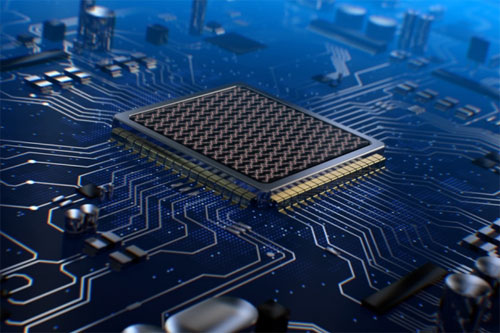Using light instead of electricity to power neural networks could improve the speed and efficiency of certain deep learning computations, especially tasks that involve repeated multiplications of matrices that can be computationally intensive for conventional CPU or GPU chips.

This futuristic drawing shows programmable nanophotonic processors integrated on a printed circuit board and carrying out deep learning computing. Courtesy of RedCube Inc. and the researchers.
While many proposed uses of photonic computers for deep learning have proven impractical, a light-based neural-network system developed by a team at Massachusetts Institute of Technology (MIT) could be useful for deep-learning for some applications.
Researchers developed an architectural concept for a fully optical neural network that could provide more efficient computational speed and power than state-of-the-art electronics for conventional inference tasks.
The researchers demonstrated the essential part of their concept using a programmable nanophotonic processor featuring a cascaded array of 56 programmable Mach–Zehnder interferometers in a silicon photonic integrated circuit. The processor guides light through a series of coupled photonic waveguides. The array of waveguides can be modified as needed, allowing a set of beams to be programmed for a specific computation. Multiple light beams interact to produce interference patterns that convey the result of the intended operation.
The team’s full proposal calls for interleaved layers of devices that apply a nonlinear activation function analogous to the way neurons operate in the brain.
The team programmed the nanophotonic processor to implement a neural network that recognizes four basic vowel sounds. The processor — a rudimentary system at this stage of development — was able to achieve a 77 percent accuracy level, compared to about 90 percent for conventional systems. There are “no substantial obstacles” to scaling up the system for greater accuracy, professor Marin Soljacic said.
According to researcher Yichen Shen, the optical chips using this architecture could, in principle, carry out calculations performed in typical artificial intelligence algorithms much faster and using less than one-thousandth as much energy per operation as conventional electronic chips.
“The natural advantage of using light to do matrix multiplication plays a big part in the speed up and power savings, because dense matrix multiplications are the most power hungry and time consuming part in AI algorithms,” he said.
“This chip, once you tune it, can carry out matrix multiplication with, in principle, zero energy, almost instantly,” said Soljacic. “We've demonstrated the crucial building blocks but not yet the full system.”
Professor Dirk Englund said that the programmable nanophotonic processor could have other applications, including signal processing for data transmission.
“High-speed analog signal processing is something this could manage. This approach could do processing directly in the analog domain,” Englund said.
Once the system is scaled up and fully functioning, the team believes it could find many uses, including in data centers or for security systems.
The system could also be used for self-driving cars or drones, said researcher Nicholas Harris, or “whenever you need to do a lot of computation but you don't have a lot of power or time.”
The research was published in
Nature Photonics (
doi:10.1038/nphoton.2017.93).